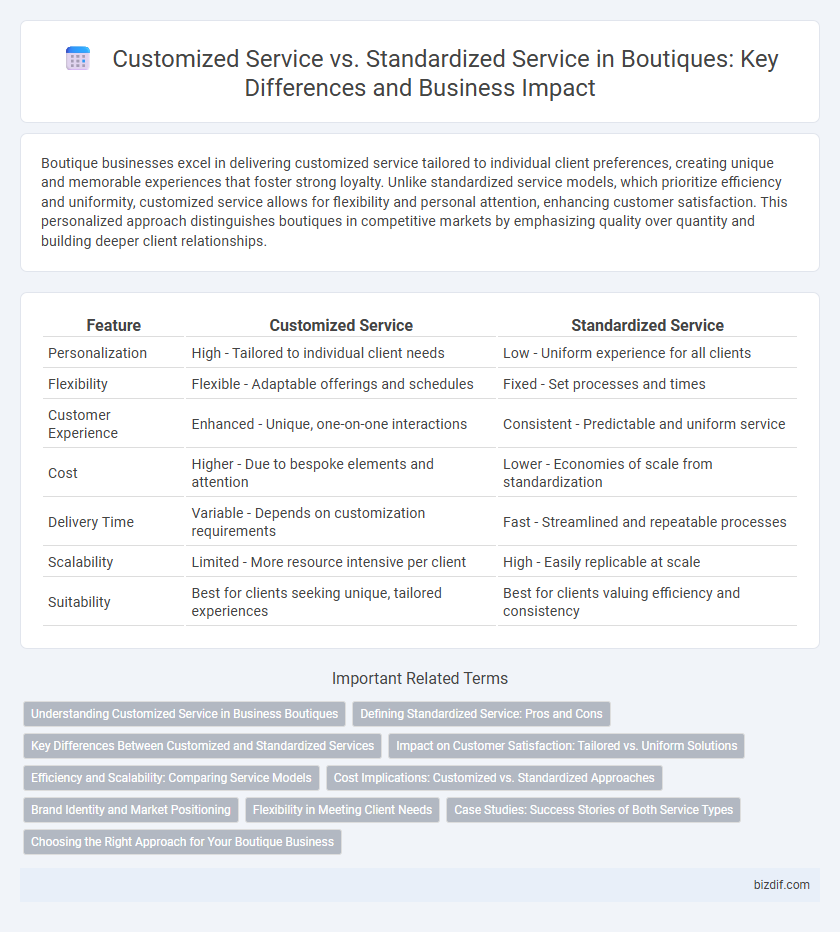Boutique businesses excel in delivering customized service tailored to individual client preferences, creating unique and memorable experiences that foster strong loyalty. Unlike standardized service models, which prioritize efficiency and uniformity, customized service allows for flexibility and personal attention, enhancing customer satisfaction. This personalized approach distinguishes boutiques in competitive markets by emphasizing quality over quantity and building deeper client relationships.
Table of Comparison
| Feature | Customized Service | Standardized Service |
|---|---|---|
| Personalization | High - Tailored to individual client needs | Low - Uniform experience for all clients |
| Flexibility | Flexible - Adaptable offerings and schedules | Fixed - Set processes and times |
| Customer Experience | Enhanced - Unique, one-on-one interactions | Consistent - Predictable and uniform service |
| Cost | Higher - Due to bespoke elements and attention | Lower - Economies of scale from standardization |
| Delivery Time | Variable - Depends on customization requirements | Fast - Streamlined and repeatable processes |
| Scalability | Limited - More resource intensive per client | High - Easily replicable at scale |
| Suitability | Best for clients seeking unique, tailored experiences | Best for clients valuing efficiency and consistency |
Understanding Customized Service in Business Boutiques
Customized service in business boutiques involves tailoring products and experiences to meet the unique preferences and needs of individual clients, enhancing customer satisfaction and loyalty. This approach leverages in-depth client insights and personalized interactions, distinguishing boutiques from mass-market competitors relying on standardized services. By prioritizing customization, boutiques can create exclusive value propositions that drive repeat business and differentiate their brand in niche markets.
Defining Standardized Service: Pros and Cons
Standardized service in a boutique context refers to delivering uniform experiences and products to all customers, ensuring consistency and efficiency. Pros include streamlined operations, predictable quality, and cost reduction due to repetition and scale. Cons involve limited personalization, potential customer dissatisfaction when unique needs are unmet, and reduced ability to differentiate from competitors.
Key Differences Between Customized and Standardized Services
Customized services in boutiques prioritize personalized experiences tailored to individual customer preferences, enhancing satisfaction and loyalty through unique product offerings and one-on-one consultations. Standardized services emphasize uniformity and efficiency, delivering consistent quality and predictability that streamline operations and reduce costs. Key differences lie in adaptability and personalization for customized services versus scalability and uniform experience in standardized approaches.
Impact on Customer Satisfaction: Tailored vs. Uniform Solutions
Customized service in boutiques enhances customer satisfaction by delivering tailored solutions that address individual preferences and needs, fostering a unique and memorable shopping experience. Standardized service offers consistent, uniform solutions that streamline operations but may lack personalization, potentially reducing emotional engagement. Personalized interactions typically result in higher retention rates and positive word-of-mouth, underscoring the value of bespoke service over generic approaches.
Efficiency and Scalability: Comparing Service Models
Customized service in boutiques offers personalized experiences tailored to individual clients, enhancing customer satisfaction but often requiring more time and resources, which can limit efficiency and scalability. Standardized service models emphasize uniform processes that streamline operations, enabling boutiques to serve a larger customer base efficiently and scale quickly. Balancing these models involves integrating personalization within standardized frameworks to optimize both client experience and operational growth.
Cost Implications: Customized vs. Standardized Approaches
Customized service in boutiques often incurs higher costs due to personalized labor, tailored materials, and extended production times. Standardized service benefits from economies of scale, reducing expenses through uniform processes and bulk purchasing. Balancing these approaches requires careful evaluation of customer willingness to pay versus operational efficiency to optimize profitability.
Brand Identity and Market Positioning
Customized service in boutiques enhances brand identity by offering personalized experiences that resonate with individual customer preferences, distinguishing the brand in a competitive market. Standardized service ensures consistent quality and efficiency, reinforcing reliability and professionalism that appeal to a broader audience. Balancing both approaches strategically positions the boutique to attract niche markets while maintaining scalable operations and strong brand recognition.
Flexibility in Meeting Client Needs
Customized service in boutiques offers unparalleled flexibility, tailoring products and experiences to individual client preferences and unique style demands. Unlike standardized service, which relies on uniform offerings designed for mass appeal, customized solutions adapt seamlessly to shifting trends and personal requirements. This personalized approach enhances client satisfaction, fostering loyalty and differentiating the boutique in a competitive market.
Case Studies: Success Stories of Both Service Types
Case studies highlight how customized service in boutiques drives customer loyalty by tailoring experiences to individual preferences, resulting in higher satisfaction and repeat business. Standardized service models demonstrate efficiency and scalability, maintaining consistent quality and meeting broad customer expectations without compromising brand identity. Both approaches show success by aligning service delivery with specific market demands and operational capabilities.
Choosing the Right Approach for Your Boutique Business
Customized service in boutique businesses fosters personalized customer experiences by tailoring offerings to individual preferences, enhancing client satisfaction and loyalty. Standardized service ensures consistency and efficiency, streamlining operations and maintaining quality across all customer interactions. Selecting the right approach depends on the boutique's target market, operational capacity, and brand positioning to balance uniqueness with scalability.
Customized Service vs Standardized Service Infographic

 bizdif.com
bizdif.com